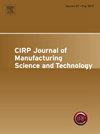桦木低温切削性能的研究
IF 5.4
2区 工程技术
Q2 ENGINEERING, MANUFACTURING
CIRP Journal of Manufacturing Science and Technology
Pub Date : 2025-04-26
DOI:10.1016/j.cirpj.2025.03.012
引用次数: 0
摘要
在木材切削加工中,降低切削时的温度可以提高加工精度和质量。然而,传统的冷却液不适合降低木材的切削温度,因为它们会污染木材的加工表面,影响操作人员的健康。超临界二氧化碳(ScCO2)冷却技术是解决这些问题的途径之一,因为ScCO2是一种可持续能源技术,可以带来高效率、环保和成本效益。分别对桦木进行干车削和ScCO2车削试验,比较了桦木在干车削过程中的切削温度、切削力和表面粗糙度特征,研究了ScCO2车削对桦木的切削性能。结果表明:在干切削和低温切削过程中,切削深度对切削温度和切削力的影响最大;ScCO2车削与干车削相比,切削区温度降低,切削力增大。随着切削温度的降低,木材纤维的脆性提高,刀具作用下产生的弹塑性变形程度变小,导致表面粗糙度降低,获得较好的加工表面质量。干切削条件下,随着切削速度的增加,表面粗糙度Ra先减小后增大;在ScCO2切削条件下,随着切削速度的增加,切削力和表面粗糙度Ra均减小。因此,在获得相同切削质量的前提下,低温切削可以采用更高的加工速度,有助于提高加工效率。本研究分析了ScCO2条件下车削桦木的加工性能,为ScCO2在木材切削加工领域的应用提供理论和应用参考。本文章由计算机程序翻译,如有差异,请以英文原文为准。
Investigation on the cryogenic cutting performance of birch
In wood cutting, reducing the temperature during cutting can improve machining accuracy and quality. However, traditional coolants are not suitable for reducing the cutting temperature of wood because they will contaminate the machined surface of the wood and affect the health of the operator. Supercritical carbon dioxide (ScCO) cooling technology is one of the ways to solve such problems, as ScCO is a sustainable energy technology that can bring high efficiency, environmental protection, and cost-effectiveness. Dry turning and ScCO turning tests were carried out on birch, respectively, to compare the results of cutting temperature, cutting force and surface roughness characteristics during the process, and to study the cutting performance of ScCO turning of birch. The results show that the cutting depth has the greatest influence on the cutting temperature and cutting force during dry cutting and cryogenic cutting. ScCO turning compared with dry turning, the temperature of the cutting area decreases, the cutting force increases. As the cutting temperature is reduced, the brittleness of the wood fibers improves, and the degree of elastic–plastic deformation produced by the action of the cutting tool is smaller, resulting in a decrease in surface roughness and obtaining better machined surface quality. Moreover, under dry cutting conditions, the surface roughness decreases and then increases with the increase of cutting speed; under ScCO cutting conditions, both the cutting force and surface roughness decrease with the increase of cutting speed. Therefore, under the premise of obtaining the same cutting quality, cryogenic cutting can use higher machining speed, which helps to improve machining efficiency. This study analyzes the machining performance of turning birch under ScCO conditions to provide theoretical and application references for the application of ScCO in the field of wood cutting processing.
求助全文
通过发布文献求助,成功后即可免费获取论文全文。
去求助
来源期刊

CIRP Journal of Manufacturing Science and Technology
Engineering-Industrial and Manufacturing Engineering
CiteScore
9.10
自引率
6.20%
发文量
166
审稿时长
63 days
期刊介绍:
The CIRP Journal of Manufacturing Science and Technology (CIRP-JMST) publishes fundamental papers on manufacturing processes, production equipment and automation, product design, manufacturing systems and production organisations up to the level of the production networks, including all the related technical, human and economic factors. Preference is given to contributions describing research results whose feasibility has been demonstrated either in a laboratory or in the industrial praxis. Case studies and review papers on specific issues in manufacturing science and technology are equally encouraged.
 求助内容:
求助内容: 应助结果提醒方式:
应助结果提醒方式:


